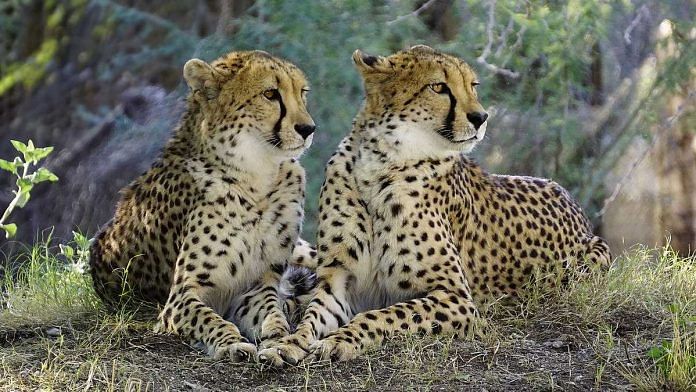Indian news, for the last few days, has been awash with celebrations welcoming its new guests, the African Cheetahs, at the Kuno National Park. The ‘cheetah reintroduction’ project is in line with the philosophy of the Bharatiya Janata Party (BJP) to reclaim India’s past. The charismatic big cat was found in several parts of India before 1952, including Madhya Pradesh, Rajasthan, Andhra Pradesh, and Gujarat, through the species was slightly different from the cheetahs that arrived as part of Project Cheetah. The project makes a huge stride in rekindling India’s enthusiasm for conservation. If this reintroduction project becomes successful, it will bring large-scale transformations in our conservation efforts. The dwindling grasslands of India will also get a boost with the reintroduction of the cheetahs, as they are a keystone species of the savanna habitat.
But the project doesn’t reintroduce the subspecies that was naturally found in India. The African Cheetah (Acinonyx jubatus jubatus) being introduced to a habitat that was once dominated by the Asiatic Cheetah (Acinonyx jubatus venaticus) is quite unnatural. Nature provides a slow translocation of species across the earth. All humans tracing their origins from Africa who migrated over several tens of thousands of years is in huge contrast with all the future cheetahs of India tracing their origins to African Cheetahs, which have been translocated artificially in just over 10 hours. The very idea of such an intervention to turn the wheel of time to the pre-1952 era is worrying. It is true that the cheetahs became extinct in India through human activities like taming and hunting. But it is also true that the grassland habitat as well as the climate of India, which supported the cheetah population earlier, have undergone several changes over the past few decades. Hence, the reintroduction of these animals into the changed habitat at such a scale is unprecedented and may have some unknown consequences as well.
Conservation of habitats and other species
According to the Ministry of Earth Sciences, the average temperature of India has risen by around 0.7 degrees celsius over the last 100 years. Between 2005 and 2015, 31 per cent of the grasslands of India have been lost. Lately, several of the species that constitute prey for cheetahs have found their names in the list of endangered species, including the Caracal and the Great Indian Bustard. Both are enlisted in the ‘Species Recovery Programme’ by the National Board of Wildlife. The Great Indian Bustard is endemic to India and is feared to follow the Dodo track of extinction with less than 100 of these magnificent birds remaining in the wild. Despite the Supreme Court firmly ordering the Rajasthan and the Gujarat governments to lay underground wiring of high-tension cables in the habitats belonging to the Great Indian Bustard, both the state governments have hardly taken any action citing the lack of funds and adverse impact on the renewable energy efforts of India.
The case of the Great Indian Bustard can be contrasted with that of the cheetah. In both cases, the Supreme Court has taken interest in the species’ conservation. However, the response of the government in the case of the cheetah’s reintroduction into India has been extremely quick compared to its unenthusiastic approach to the conservation of the Great Indian Bustard. This highlights a fallacy in our approach to wildlife conservation.
Underlying issues in our environmental policies
There is an underlying problem in the way India perceives development and in its interaction with wildlife. Prioritising industrial and energy needs at the cost of degradation of our natural environment will not bode well with our so-called conservation efforts. The grasslands being termed as ‘wastelands’ is one manifestation of our disdain towards the same habitat that is sought after by our fauna, including the Asiatic Lions, the Great Indian Bustards, and now the reintroduced cheetahs. The encroachment of grasslands by industries is allowed by our policies. In 2018, an expert committee of the Ministry of Environment, Forests and Climate Change recommended leasing out these ‘wastelands’ to the private sector for ‘re-greening’. Allowing indiscriminate construction in urban areas and relaxing the norms of development near coastal areas of India are other examples highlighting our misplaced priorities.
While the African cheetahs have been received by the Indians with great pomp and show, there are apprehensions of the event being a vanity project instead of initiating a wider debate on the issue of wildlife conservation approach. Apparently, it seems that much has been spent on the advertisements and branding of Project Cheetah. Although it is important to increase the awareness of the people for this reintroduction project to become a success, it is equally important (if not more) that the species that are endemic to India are brought into focus with respect to their conservation. It is these species that are a true manifestation of the Indian soil, climate, habitat, and culture.
The conservation efforts of the Asiatic Lion, endemic to the Gir National Park in Gujarat, have been largely successful. However, conservationists fear the population being wiped off in the event of an epidemic or a natural disaster owing to their concentration in a single geographical location. To allay these fears, a second population of the Asiatic Lions has been proposed in the Kuno National Park. However, the introduction of cheetahs into this park has delayed the establishment of the second population of these endemic lions.
While Project Cheetah has made earnest efforts to turn back the wheel of time and redress the past human excesses, it is important that we make more efforts on conserving our present, so that the need for such reintroduction projects doesn’t arise in the future. The time has come for an overarching nature-centric attitude governing our policies and a paradigm shift in the way Indian society views and interacts with the environment.
Prateek Yadav is a student at the Indian Institute of Technology, Kanpur. Views are personal.







